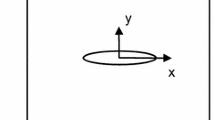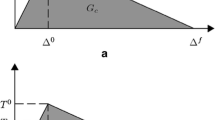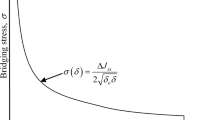Abstract
The progressive failure behavior of a unit composite lattice structure under compressive load was predicted using cohesive zone model (CZM). Mode I, II and mixed mode I/II interlaminar fracture toughness tests were conducted to obtain a set of cohesive zone parameters. To predict failure behavior through numerical analysis, a FEM was generated by considering the three problems of composite lattice structure: differences in the fiber volume fraction, discontinuity in mechanical properties, and generation of wedge-shaped resin rich parts. To select the position of cohesive elements, first numerical analysis was performed, and cohesive elements were applied to the layer with the highest failure index of quadratic nominal stress criterion. The results of numerical analysis with cohesive element were well matched with the test result. These results showed that CZM based numerical analysis method is an effective way to predict and evaluate the onset and growth of progressive failure of unit composite lattice structure.
Similar content being viewed by others
Abbreviations
- a :
-
Crack length
- a c :
-
Distance between hoop ribs
- a h :
-
Distance between helical ribs
- b :
-
Width of the specimen
- c :
-
Lever length
- E f :
-
Fiber modulus
- E L :
-
Longitudinal direction modulus
- E m :
-
Matrix modulus
- E T :
-
Transverse direction modulus
- G I :
-
Mode I energy release rate
- G II :
-
Mode II energy release rate
- G Ic :
-
Critical energy release rate for mode I
- G IIC :
-
Critical energy release rate for mode II
- G C :
-
Sum of GIC and GIIC
- G T :
-
Total energy release rate
- H :
-
Thickness of lattice structure
- h :
-
Half-thickness of specimen
- K :
-
Cohesive stiffness
- L :
-
Half-span of specimen
- L’ :
-
Length of lattice structure
- M :
-
Mass of lattice structure
- N max :
-
Maximum interlaminar normal tensile strength
- P :
-
Load
- R :
-
Radius of lattice structure
- S max :
-
Maximum interlaminar sliding shear strength
- T max :
-
Maximum interlaminar scissoring shear strength
- δ :
-
Displacement
- δ c :
-
Thickness of hoop rib
- δ f :
-
Cohesive ductility
- δ h :
-
Thickness of helical rib
- λ :
-
Crack length correction parameter
- ν f :
-
Fiber Poisson ratio
- ν m :
-
Matrix Poisson ratio
- ρ c :
-
Density of hoop rib
- ρ h :
-
Density of helical rib
- σ n :
-
Nominal stress in the pure normal direction
- ρ s :
-
Nominal stress in the first shear direction
- ρ t :
-
Nominal stress in the second shear direction
- τ i (I = 1, 2, 3):
-
Interfacial normal or shear tractions for pure mode i
- ρ ulf :
-
Ultimate stress
References
V. V. Vasiliev and A. F. Rasin, Anisogrid composite lattice structures for spacecraft and aircraft applications, Composite Structures, 76 (2006) 182–189.
V. V. Vasiliev, V. A. Barynin and A. F. Rasin, Anisogrid lattice structures-survey of development and applications, Composite Structures, 54 (2011) 361–370.
V. V. Vasiliev, V. A. Barynin and A. F. Razin, Anisogrid composite lattice structures-development and aerospace applications, Composite Structures, 94 (2012) 1117–1127.
V. A. Barynin, V. A. Bunakov, A. F. Rasin and V. V. Vasiliev, Aerospace composite lattice structure, Proc. of ICCM, Paris, France (2009).
M. Belardo, N. Paletta and U. Mercurio, Conceptual design of the composite sandwich fuselage of a re-entry vehicle, Materialwissenschaft und Werkstofftechnik, 46(4–5) (2015) 420–430.
P. K. Krishan and P. Muruganantham, Design and analysis of a typical inter-tank structure of a launch vehicle using integrally stiffened construction, International J. of Research in Engineering and Technology, 1(1) (2013) 21–34.
O. M. Querin et al., Topology and Parametric Optimization of a Lattice Composite Fuselage Structure, Altair University, Retrieved April 13 (2021) https://altairuniversity.com/wp-content/uploads/2014/04/Topology_and_Parametric_Optimization-of-a-Latice_Composite_Fuselage_Structure_as_published.pdf (2014).
H. Kanou, S. M. Nabavi and J. E. Jam, Numerical modeling of stresses and buckling loads of isogrid lattice composite structure cylinders, International of Engineering, Science and Technology, 5(1) (2013) 42–54.
ASTM D5528, Standard Test Method for Mode I Interlaminar Fracture Toughness of Unidirectional Fiber-reinforced Polymer Matrix Composites, ASTM International (2001).
ASTM D6671, Standard Test Method for Mixed Mode I-Mode II Interlaminar Fracture Toughness of Unidirectional Fiber Reinforced Polymer Matrix Composites, ASTM International (2006).
ASTM D6641, Standard Test Method for Compressive Properties of Polymer Matrix Composite Materials Using a Combined Loading Compression (CLC) Test Fixture, ASTM International (2009).
R. F. Gibson, Principles of Composite Material Mechanics, CRC Press, Florida, USA (2011).
W. D. Callister, Jr. and D. G. Rethwisch, Fundamentals of Materials Science and Engineering: An Integrated Approach, 2nd ed., Wiley, Hoboken, USA (2004) 592.
D. Hull and T. W. Clyne, An Introduction to Composite Materials, 2nd ed, Cambridge University Press, New York, USA (1996) 177–179.
W. Cui, M. Wisnom and M. Jones, A comparison of failure criteria to predict delamination of unidirectional glass/epoxy specimens waisted through the thickness, Composites, 23(3) (1992) 158–166.
P. P. Camanho, C. G. Davila and M. F. de Moura, Numerical simulation of mixed-mode progressive delamination in composite materials, J. of Composite Materials, 37(16) (2003) 1415–1438.
M. Kenane and M. L. Benzeggagh, Mixed-mode delamination fracture toughness of unidirectional glass/epoxy composites under fatigue loading, Composites Science and Technology, 57(5) (1997) 597–605.
T. Diehl, On using a penalty-based cohesive-zone finite element approach, part I: elastic solution benchmarks, International J. of Adhesion and Adhesives, 28(4) (2008) 237–255.
J. M. Im, S. G. Kang, K. B. Shin and T. K. Hwang, Prediction of onset and propagation of damage of in the adhesive joining of a dome-separated composite pressure vessel including temperature effects, International J. of Precision Engineering and Manufacture, 18(12) (2017) 1795–1804.
Author information
Authors and Affiliations
Corresponding author
Additional information
Jae-Moon Im is a Ph.D. candidate in Mechanical Engineering, Hanbat National University, Daejeon, Rep. of Korea. His research interest is in composite materials and structures.
Kwang-Bok Shin is a Professor of Mechanical Engineering, Hanbat National University, Daejeon, Rep. of Korea. His research interest is in composite material, composite structures and CAE.
Rights and permissions
About this article
Cite this article
Im, JM., Shin, KB. Study on the prediction method of onset and propagation of damage of unit composite lattice structure. J Mech Sci Technol 36, 3081–3088 (2022). https://doi.org/10.1007/s12206-022-0538-3
Received:
Revised:
Accepted:
Published:
Issue Date:
DOI: https://doi.org/10.1007/s12206-022-0538-3




